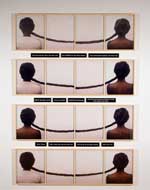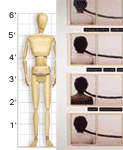VAM galleries including this work:
The Speed Art Museum | How’d They Do That? | What’s in a Name? || VAM Home
Lorna Simpson (American, b. 1960)
SAME, 1991
16 color Polaroids with 11 plastic plaques; 119" X 82-1/4" (302.3 X 208.9 cm.) overall
Gift of the New Art Collectors 1991.22.2
The Speed Art Museum
Used courtesy of the artist and Sean Kelly Gallery, New York
One of contemporary photography artist Lorna Simpson’s major themes is the identity and situation of African-American women in society.
In Same, the viewer is struck by the stark color contrast of photographs of the backs of African-American women’s heads that are connected to one another by a long black braid. With the backs of the heads facing the viewer and set against a white background, the viewer is denied the opportunity to gaze upon the faces of these women. The female “object” in these photographs actively looks beyond from within the photographic frame.
Beneath the photographs are black plaques with words engraved in them. They contain phrases like “they pronounced water the same way,” “were disliked for the same reasons,” “read w/the same accent,” and “were not related.” These phrases describing certain shared experiences seem to relate to the images of the black female.
About the Artist
Lorna Simpson was born in Brooklyn, New York in 1960. She was trained in traditional photography techniques at the School of Visual Arts in New York and began her career as a documentary photographer. In the mid-1980s, she began to explore themes of racial and gender stereotyping along with innovative approaches to the medium of photography, such as the combining of images and words.
Because her work uses ideas as a kind of “material” from which to create, it is thought of as Conceptual Art, which took hold during the 1960s but traces its origins to the early 1900s with the art of Marcel Duchamp.
Simpson’s influences include feminist photographers of the 1970s such as Barbara Kruger, Sherrie Levine, and Cindy Sherman. Sherman created a series of mock, or fake, film stills in which she photographed herself dressed up as vain, daydreaming women and other stereotypical female roles. This work explored how women are unfairly represented as passive objects to be looked at in film. Simpson’s photos also raise questions about how the identity of women, both black and white, is created through male representations of them in painting, film, and advertising.
Classroom Ideas
Discussion: Conduct a visual inventory of the work. What does it say to you? Look at a variety of images with text, such as advertisements or news photos, and discuss their use of art elements and design elements, as well as their overall impacts. Would you interpret the pictures differently if the text were not present?
Lorna Simpson uses photography as one of several artistic media to convey her ideas. Other contemporary women photographers use that medium as their primary artistic tool. Look at the photographic work of artists Cindy Sherman, Sandy Skoglund, and Diane Arbus and compare it to Lorna Simpson’s Same. Analyze how Simpson’s use of photography differs from other contemporary artists’.
Activities: Take photographs of people using different angles and views to convey different impressions and ideas. Write an artist’s statement about the process and your intentions with the artwork. Display the photographs with the statements and discuss as a class.
Working in groups, research historical images of men or women from a variety of cultures or periods. Look for changes over time in the way they are portrayed. Give a presentation on your research. Compare and contrast the portrayals from various cultures or periods.
Links
You’ll find links to online examples of Lorna Simpson’s work in the Artcyclopedia.
[www.artcyclopedia.com/artists/simpson_lorna.html]
Learn more about Conceptual Art and Artists at Wikipedia.
[en.wikipedia.org/wiki/Conceptual_art]

